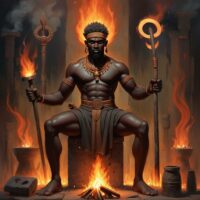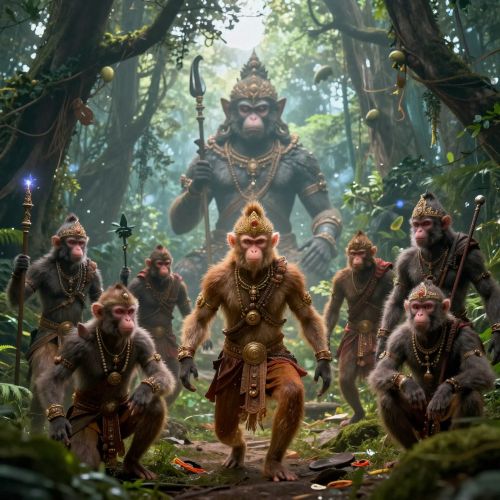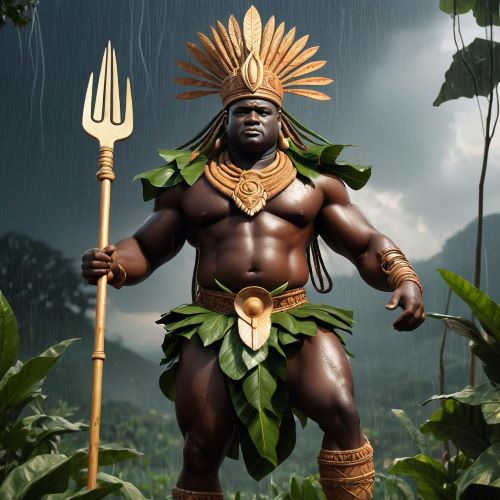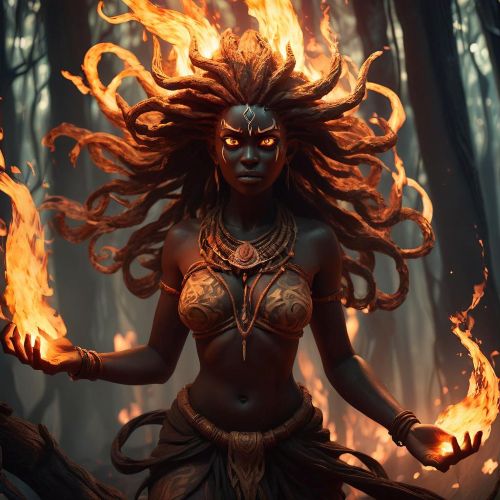
Ndomadyiri : God of Healing
Listen
At a glance
| Description | |
|---|---|
| Origin | Bambara Mythology |
| Classification | Gods |
| Family Members | N/A |
| Region | Mali |
| Associated With | Earth, Healing, Fire |
Ndomadyiri
Introduction
In the rich spiritual tradition of the Bambara people of Mali, Ndomadyiri stands out as a revered deity symbolizing fire, healing, and stability. Unlike primordial deities who usher in creation, Ndomadyiri emerges later in the cosmic narrative as a sustaining force—an entity that nurtures life, brings spiritual order, and serves as a bridge between the divine and human worlds. As part of the divine quaternity known as Bemba, which includes Pemba, Faro, and Nyale, Ndomadyiri represents the grounding element of earth and the transformative power of fire. His presence reinforces the harmony established by earlier deities, and his domain extends across both physical craftsmanship and sacred ritual healing.
Physical Traits
Rather than a clearly defined bodily form, Ndomadyiri is more often envisioned as a spiritual force that channels the essence of fire and craftsmanship. In myth and ritual, he is portrayed as a blacksmith deity—his body imagined to glow with embers or ripple with flames, reflecting his command over heat and transformation. Fire doesn’t just symbolize destruction in his case—it signifies renewal, purification, and divine craftsmanship. The forge becomes his sacred altar, and the tools of a smith—anvil, hammer, and tongs—are seen as instruments of both physical creation and spiritual change.
Family
Unlike deities who belong to a genealogical family tree, Ndomadyiri functions as one of four aspects of a single supreme god, Bemba. This theological structure in Bambara mythology isn’t about parentage or succession but about elemental harmony. Each member of this divine quaternity—Pemba (air and seeds), Nyale (fire and chaos), Faro (water and fertility), and Ndomadyiri (earth and healing)—holds dominion over a distinct cosmic principle. Ndomadyiri’s relationship with Faro is especially significant, as it represents the essential balance between fire and water, healing and growth. Together, they ensure the continuity and equilibrium of creation, embodying a cosmic duality found in many West African spiritual systems.
Other names
Though most commonly known as Ndomadyiri within the Bambara belief system, his identity is occasionally blended into the broader spiritual identity of Bemba in oral traditions. Some interpretations across the Mande cultural zone may associate him with Ngala or simply identify him through his function as “the blacksmith healer.” While he doesn’t have a wide array of epithets or alternative names like some deities in larger pantheons, his essence is deeply resonant. Scholars often compare him to fire and forge deities from neighboring mythologies, such as Shango of the Yoruba or Gun of the Fon people, though Ndomadyiri retains a more healing-centered role unique to Bambara cosmology.
Powers and Abilities
Ndomadyiri wields a set of extraordinary abilities rooted in his mastery over fire and earth. Central to his power is the dual nature of fire—it can both destroy and purify. Through fire rituals, he is invoked to cleanse physical illness and spiritual corruption, casting out malevolent forces from individuals and communities. In some myths, he is credited with saving entire villages by banishing darkness through ceremonial flames or forging enchanted weapons to fend off chaos-spirits.
His blacksmithing talents go beyond metallurgy; they are spiritual acts of transformation. When he strikes metal, it’s believed that he also shapes human destiny, fusing raw material into sacred tools imbued with protective or healing properties. Objects forged in his name often carry symbolic inscriptions or are used in rituals, indicating that he not only creates but consecrates.
The priests and ritual specialists who work in his tradition often channel his energy through controlled fire—burning sacred herbs, chanting invocations, and sometimes walking on embers as acts of devotion and purification. These practices are not mere spectacle but intentional communions with the divine, aimed at restoring order in times of disease, drought, or social disruption.
Modern Day Influence
Despite the rise of Islam and Christianity across much of Mali and West Africa, the figure of Ndomadyiri has not vanished. Instead, his presence lingers in blended spiritual systems and folk traditions, particularly among those who still practice indigenous Bambara rites. Fire remains a central element in purification ceremonies, often performed to this day by traditional healers who trace their practices back to Ndomadyiri’s teachings. The firewalkers, herbalists, and smiths who serve rural communities are modern echoes of his enduring influence.
In contemporary cultural expressions, Ndomadyiri’s role as a healer and artisan has gained symbolic value beyond religion. In literature and visual arts, he embodies resistance, transformation, and the importance of tradition in a rapidly changing world. His legacy resonates in ecological thought as well—fire as a force that both consumes and regenerates finds a parallel in how we approach environmental sustainability and cultural renewal.
Moreover, his myth contributes to modern explorations of African identity, tradition, and innovation. As interest grows in decolonizing knowledge systems and celebrating indigenous wisdom, figures like Ndomadyiri offer an alternative narrative—one where healing, craftsmanship, and harmony with the elements are central to human survival and spiritual fulfillment.
Related Images
Source
Wikipedia contributors. (2021, March 21). Bemba (deity). Wikipedia. https://en.wikipedia.org/wiki/Bemba_(deity)
Encyclopedia.com. (2025, March 11). Bambara Religion. https://www.encyclopedia.com/environment/encyclopedias-almanacs-transcripts-and-maps/bambara-religion
TV Tropes. (2019, November 26). Myth / Mande Mythology. https://tvtropes.org/pmwiki/pmwiki.php/Myth/MandeMythology
Springer. (2006). Beliefs and practices concerning twins, hermaphrodites, and albinos among the Bamana and Maninka of Mali.
MIT Press. (2008). Twins, hermaphrodites, and an androgynous albino deity: Twins and sculpted twin figures among the Bamana and Maninka of Mali.
Mystery in History. (2025, April 12). Ndomadyiri: The Fire God and Healer in Bambara Mythology. https://mysteryinhistory.com/ndomadyiri/
SpringerLink. (2022). Bambara – beliefs, economic and religious aspects.
JSTOR. (1990). Camara Laye’s L’Enfant noir and the Mythical Verb.
Frequently Asked Questions
What is lorem Ipsum?
I am text block. Click edit button to change this text. Lorem ipsum dolor sit amet, consectetur adipiscing elit. Ut elit tellus, luctus nec ullamcorper mattis, pulvinar dapibus leo.
What is lorem Ipsum?
I am text block. Click edit button to change this text. Lorem ipsum dolor sit amet, consectetur adipiscing elit. Ut elit tellus, luctus nec ullamcorper mattis, pulvinar dapibus leo.
What is lorem Ipsum?
I am text block. Click edit button to change this text. Lorem ipsum dolor sit amet, consectetur adipiscing elit. Ut elit tellus, luctus nec ullamcorper mattis, pulvinar dapibus leo.
What is lorem Ipsum?
I am text block. Click edit button to change this text. Lorem ipsum dolor sit amet, consectetur adipiscing elit. Ut elit tellus, luctus nec ullamcorper mattis, pulvinar dapibus leo.
What is lorem Ipsum?
I am text block. Click edit button to change this text. Lorem ipsum dolor sit amet, consectetur adipiscing elit. Ut elit tellus, luctus nec ullamcorper mattis, pulvinar dapibus leo.







